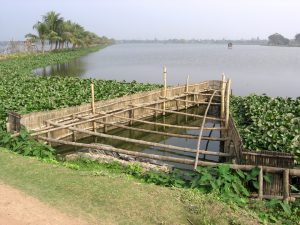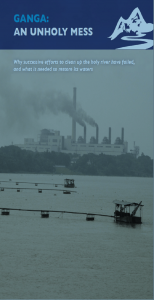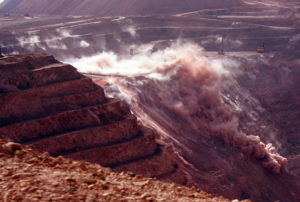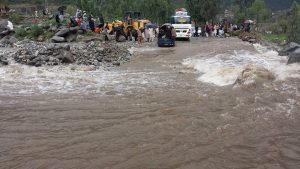Even as the blistering heat sucks lakes and rivers dry in the southern state of Kerala, water flows continuously through the Thoothapuzha river. The river is in no hurry as it lazes past Thootha village, flowing between reed clumps and jumping over half-buried rocks. In the morning and at dusk, when the sun’s rays hit the river at an angle, a bevy of smooth-coated otters (Lutra perspicillata) are seen playing and fishing in the river.
Otters have returned to the Thoothapuzha. The residents of Thootha remember to have seen plenty of them nearly two decades ago. They disappeared for many years and were seen again in the river in the past year.
Otters are top level predators in this riverine ecosystem. Their return to a river is akin to tigers returning to a forest. It indicates that the ecological health of the river has improved, there is plenty to eat for the otters, and there is a natural habitat safe enough for them to breed.
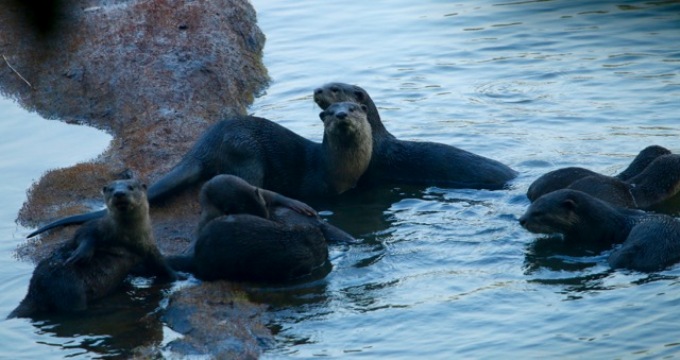
Villagers in Thootha say the return of the otters could have been due to the river conservation activities they have been carrying out in the recent years. “In my childhood, it was common to sight otters when we swam in the river,” said C.P. Hamid, a 45-year-old bus owner. “Around 15 years ago, we stopped seeing them totally, and now we see them occasionally in areas where there aren’t much human movement. This is a good indication.”
“We have been working to stop open defecation on the river banks, and also dumping of waste,” said Nasser Thootha, a social and political activist. “We keep watch at night to prevent drivers from taking their trucks into the river for washing. We have managed to reduce this by 80%, which is a major achievement. There was a time a few years ago when the river used to stink and even bus passengers covered their noses when passing over the bridge. Fortunately, it is not so today.”
A local group under the banner of Thoothapuzha Samrakshana Samithi carried out a river cleaning campaign a few months ago. They gathered the youth and schoolchildren from the village to clean the river. “This activity raised the awareness of the community on their relationship with the river ecosystem and the need for its conservation,” said Mohammed Iqbal, a local businessman.
No dynamite
“A few years ago we managed to stop fishing from the river using dynamite sticks, and that would have improved the fish population in the river,” said Hamid. When dynamite sticks are exploded in a river, fishes die en masse and float, thereby making it easy for fishermen to harvest them. However, in the process they destroy non-targeted species and juveniles, destroying fish diversity and productivity.
Similarly, the group’s effort to prevent sand mining in the river has met with reasonable success, though they have not been able to stop it completely. These activities have had an impact on the otters returning to Thoothapuzha, the group members say.
“From our understanding, we need to give space for the otters and also ensure that little waste finds its way into the river. Our efforts are to continue to make this possible,” commented Iqbal.
Nasser says the group has requested the local panchayat (village council) to allocate funds for cleaning the river. According to M.V. Sini, Aliparamb panchayat president, new programmes on environment conservation will be launched when her team starts its work in the new financial year starting April 1.
Revi Unni, a bank officer and wildlife photographer who has been sighting otters from his home along the river regularly in the past few months, confirms that it must be the conservation activities that have helped the animals to return. “The fish quantity has increased in the river because dynamite fishing has ended. Water quality improved when a starch factory upstream stopped its operations because of financial unviability,” he observed.
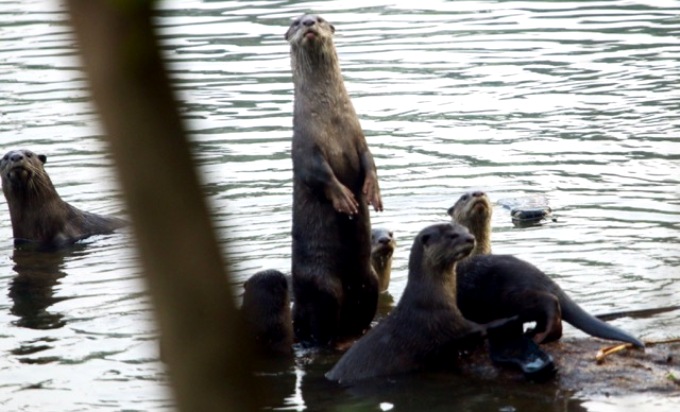
N. Ali, a traditional fisherman in Thoothapuzha, moved out of fishing into trading a few years ago when the catch declined. He says the otters come when the fish in the river increases. However, with the presence of the otters, the fish catch may drop.
Wildlife biologists say the citizen group’s action would have indirectly helped in getting otters back into the river. “Otters are the top predators in a wetland ecosystem,” said S.A. Hussain, scientist at the Wildlife Institute of India (WII) and the IUCN otter expert for India. “In the rivers, otters are what the tigers are in forests. So when they return, it means that there is enough to eat in the river and the ecosystem health is improving.”
The presence of otters also benefits the river system, according to Hussain. They eat slow and diseased fish, preventing the spread of fish diseases. They also prefer to eat the invasive fish species, thus maintaining the population of the native species. Hussain and his then student K.R. Anoop had published a paper in the Journal of Zoological Society of London stating that smooth-coated otters in the Periyar dam reservoir were seen to eat the exotic tilapia and European carp, instead of the native Deccan mahsheer and endemic Periyar barb.
K.R. Anoop, now a forest officer in Rajasthan, had studied the presence of otters in Kerala’s rivers as a student at the WII. “Otters move along locations in a river searching for good living conditions. Being the apex (top level) predators in the aquatic system, they help in maintaining a good fish population.”
Wildlife biologist Aathira Perinchery says otters are considered bio-indicators since their presence signifies improvement in water quality and availability of fish and other aquatic animals. They, however, try and avoid human habitations. By creating a better environment and reducing human activity in the water and along the banks — where they make their dens and breed — the community at Thootha would have encouraged them to return.
Otter adaptation
“They are adaptable animals, and their ability to adjust to changes in water levels — and consequently, food resources — could hold them in good stead in the face of climate change. Thus the ecosystems they are part of too would be better off, and more resilient,” Aathira said.
The ecosystem benefits from Thoothapuzha are tangible. Starting mid-February, Kerala is experiencing high heat and dry weather. Though it is not unusual for Kerala to be hot in February/March as a precursor to southwest monsoon that is timed to reach the coast in June, the dry weather is unusual. As breeze picks up moisture from the Thoothapuzha, it gives respite to those living along the river. There is water in the wells and enough flowing in the river for people to wash and bathe.
The adjoining Bharatapuzha, into which Thoothapuzha empties its contents downstream, is running dry, and the panchayats taking their drinking water from wells on the riverbank have asked for water from elsewhere.
Bharatapuzha is one of the most important rivers of Kerala. Starting from the Western Ghats and flowing through three districts — Palakkad, Malappuram and Thrissur — the river’s water supports thousands of acres of rice fields and other farmland. Its water also supports industries and the drinking water needs of towns and villages. Thus, even when Bharatapuzha dries, the replenishing water from Thoothapuzha helps in maintaining an economic lifeline.
The villagers at Thootha do not understand concepts discussed at international climate negotiations. Their efforts to conserve and protect the Thoothapuzha are to ensure a healthy environment and source of water for themselves. In the process, the otters have returned, indicating that their efforts are bearing fruit. Also, they have gifted themselves climate resilience, protecting them from the present hot and dry weather.

